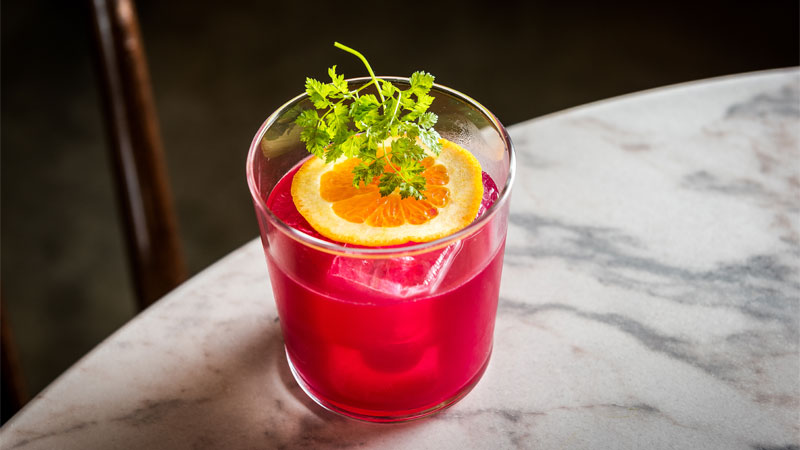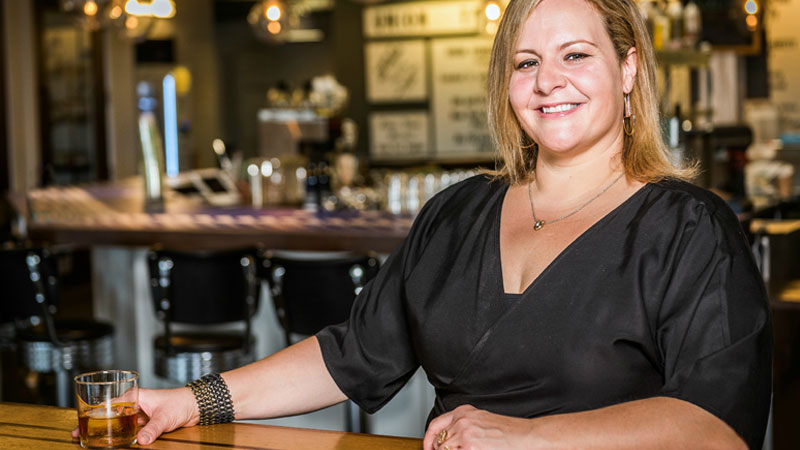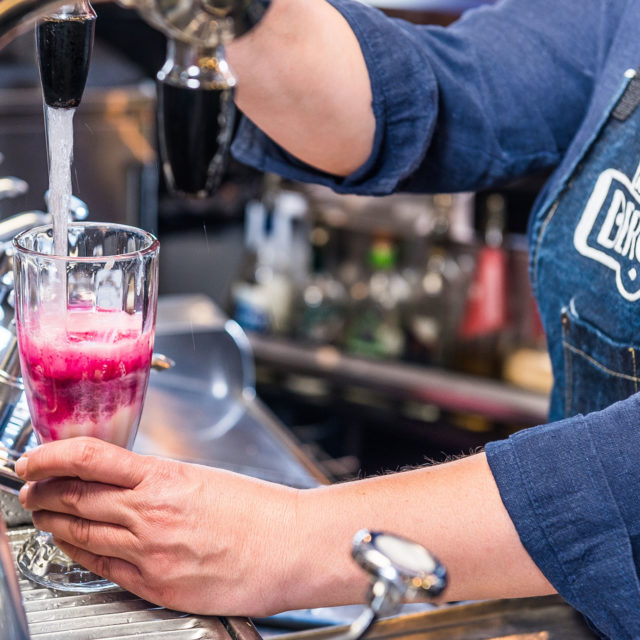
Growing up in working-class Brooklyn in the 1980s, Gina Chersevani had fairly limited dining options, and she liked it that way. Her family owned a pizzeria she sometimes worked at. A nice Jewish couple down the block had a soda shop called Norma’s, where she loved to grab knishes and egg creams. On weekends she might head out to Coney Island to visit relatives, where she’d eat hot dogs and french fries.
“I came from a place where simple food really defines our neighborhoods. Bagel shops. Pizza places,” Chersevani says. “They’re so simple, but you really have to be great if you want to succeed. I wanted to carry that culture with me to my bar.”
Chersevani began her bartending career slinging beer-in-a-bucket specials at a club at the University of Maryland. After college she briefly worked at Penang, an Asian fusion restaurant in Washington, D.C. In 2001, she headed back to New York to bartend at Penang’s location on the Upper West Side. Her return coincided with the start of NYC’s cocktail movement (“Oh shit, you have to use real juice!”).
After a couple of years she moved back to D.C. and started bartending at restaurants with such noted chefs as Jamie Leeds (15 Ria, Hank’s on the Hill), Rob Weland (Poste Moderne Brasserie), and Vikram Sunderam (Rasika). She built a name as one of the top mixologists in the city, adopting the nickname “The Mixtress.”

For her first solo venture, however, she decided to return to childhood. In late 2012, she opened Buffalo & Bergen — named after the Crown Heights, Brooklyn cross streets where Chersevani’s mother grew up — in the gourmet food hall Union Market. It served the beloved foods of Chersevani’s youth, at first focusing solely on knishes.
Unfortunately, most D.C. locals considered those Jewish delicacies to be “Martian food,” Chersevani says. Adding authentic New York bagels helped business quite a bit, but she realized she would need a legitimate cocktail program to engender more all-day support.
Chersevani wanted to return to her Brooklyn roots for that, too. She decided the bar would specialize in spiked sodas prepared via a classic, old-timey fountain. It just made sense, especially in light of the restaurant’s tight, U-shaped counter space.
“When you have a cocktail bar, what’s the biggest clutter? Syrup and tincture containers,” Chersevani says. “Soda organizes all that crap. It was a no-brainer.”
In inadvertently creating this sui generis beverage program, Chersevani still managed to nail several trends right on the nose (painstakingly hand-hewn production, nostalgia, locality, and seasonality) while offering drinks no one else is even really attempting in a town still trying to make a name for itself on the world cocktail scene.
These deeply ambitious cocktails — like Deeply Rooted, which matches Avua Cachaca Amburana and Luxardo Maraschino with a housemade gentian root soda — have, nonetheless, been such crowd-pleasers that Chersevani is now on the verge of opening a second location. Her new, standalone space in Capitol Hill will have a larger bar and longer service, but an antique soda fountain will still be its centerpiece.
Fountain Life
Soda fountains flourished in America in the early-1900s, and their heyday, especially around Brooklyn, was in the immediate post-World War II era. They started falling out of favor in 1970s, when customers began to switch to corn syrup-crammed, factory-canned, conglomerate-owned sodas.
Thus, as you might guess, finding a vintage soda fountain is not exactly easy these days. Few are actually left in the entire world. After a nationwide search in 2012, prior to opening the first Buffalo & Bergen location, Chersevani finally located a 1930s Bastian-Blessing model in Chicago that had once been used at a local Woolworths. The cost? $50,000.
A steep price, of course. Still, she thought it would be worth it, mainly because it would give her the ability to finally make drinks from a bygone era — sodas, seltzers, and egg creams — that would pair perfectly with her food and inform her cocktail program as well. She had messed around with making sodas before, using mostly siphons when she was bartending at Rasika, but admits those had been very generic, like a cherry-turmeric soda. “I just didn’t know how to do a lot of stuff,” she says. She was ready to up her soda game.
And, while a Bastian-Blessing may look like obsolete technology, or a hipster’s affectation, it is actually still quite state-of-the-art. Its unique design gives Chersevani superior mastery over the carbonation and flavor in her sodas unlike every other bartender who simply has a soda gun or SodaStream. Believe it or not, the interior of the machine uses leather gears and leather washers; this gives her way more control than metal or plastic might. She can subtly manipulate her sodas’ bubble sizes, tighter or larger, depending on what the flavor dictates. The arm of the fountain moves 45 degrees, meaning, in theory, there are 45 different sizes of bubbles.
“That’s crazy when you think about it,” Chersevani notes. “So it really becomes about the feel. When you nail the feel — the ‘jerk’ — when you really get it, it becomes more special.”
If your classic sports bar soda gun is set at around 13 psi (pounds per square inch), her fountain’s psi is typically set at 23. In winter, with more root-based drinks, she moves it closer to 27 psi. Anything after 30 psi and she suspects you’d break your machine. That wouldn’t be great as there are only three guys in America that know how to repair the fountain — that’s why Chersevani has begun to teach herself.
“If it breaks during service, we start bringing in siphons and start double charging them,” she explains. “That’s our crash kit, so we always have that backup.”
If the recent cocktail revolution kicked off in the late-1990s/early-aughts, you could argue we’re currently in the early stages of a cocktail soda revolution. No longer are drinkers satisfied with making even basic mixed drinks using plastic liters of Canada Dry tonic or store-brand soda water; artisan makers like Fever-Tree and Q Drinks have begun to boom. At the bar level, the Highball has taken off and almost become fetishized in the last year or two.
In 2017, Suntory even introduced a $5,000 Highball machine — it can only make a Toki Japanese whiskey and soda — in select bars and restaurants in key American cities. And, while plenty of spots now make their own flavored sodas for use in cocktails —look at Brigitte in Manhattan or Clyde Common in Portland — Buffalo & Bergen is the only cocktail bar in America using a $50,000 vintage machine to do so. A machine that would look more appropriate in an episode of “Leave it to Beaver” than, well, what exactly is Buffalo & Bergen?
“I realized what we accidentally created is a ‘bagel bar,’ which doesn’t really exist anywhere else,” explains Chersevani. “Where would you go in New York City to get bagels and a cocktail? Nowhere.” (She does note that you can go to Russ & Daughters Cafe and get a Bloody Mary alongside your bagel with lox — but you can’t also take a dozen bagels to go like you can at her spot.)
Unfortunately for Chersevani, there was really no business plan for how to run a bagel bar. You can look up business plans for any restaurant idea on planet Earth — Mexican, Italian, high-end fine dining, or cheap-o delis — to get a snapshot of what equipment you need to order, what supplies you will eventually need. But, Chersevani had no template to work from and, thus, had to do a bunch of guess work. (This is a big problem that has led to her currently having a packed storage unit with items like an $8,000 TurboChef [essentially a rapid toaster oven] that she thought she would need, but quickly learned she has no use for.)
Of course, necessity is the mother of all invention, and the lack of any past examples of bagel bars would force Chersevani to forge her own path, making carbonated cocktails that follow an unexpected culinary bent.
Soda Pop Culture
“My career really took off when I started working with chefs and so I started really following their patterns,” she explains. “Chefs’ menus are seasonal and I knew I wanted my sodas to also read like a farmers’ market.”
Thus, in the spring Buffalo & Bergen’s cocktails include a lot of berry sodas. Those change to stone fruits and melon sodas in July and August. In fall you might see carrot and pumpkin sodas. Moving into winter Chersevani focuses more on root sodas, some of the most innovative things she makes. She’s really proud of her celery root soda, which she uses in a variety of more savory cocktails that typically employ gin as a base.
Her current batch of winter cocktails include a pineapple-cardamom soda, a lemon-lavender option, and even an orange sassafras one that pairs great with rum- and bourbon-based cocktails. As far as she can tell, there’s only one thing she has been unable to turn into a cocktail soda.
“White potato has no business in a drink,” Chersevani explains, though she tried her damndest to crack it. “I don’t like the word ‘no,’ and I said we’re going to figure this out. It works as a puree. Fuck! We should totally be able to make a soda out of it. Guess what? Potato has no interest in being friends with soda.”
Buffalo & Bergen typically offers 20 cocktails at any given time — about half the menu utilizes the soda fountain and is, thus, carbonated — but the other half is still quite avant garde. Like Rye Beet-ween the Lines, essentially a rye Manhattan featuring roasted beets. Even her standard Bloody Mary, called Lox’d & Loaded, uses a housemade tomato puree and comes with an everything bagel with all the fixins teetering on top of the vintage milkshake glass.
She’s likewise started playing with pickled ingredients and even fermented syrups — taking nearly rotten fruits and herbs, packing them in salt and aging them for a few days, then taking the resulting strained liquid to use as a cocktail sweetener. She’s particularly enjoyed doing this with a beloved, but kinda gross, local delicacy.
“Here in Virginia, we have pawpaws. They just fall on the ground and you don’t know what they are,” she says. “They rot and animals eat them. Most people have no idea they even taste good, but only when they are literally on the verge of being too rotten to eat.”
It’s not just the seasons or even local flavors that inspire Chersevani’s drinks. Sometimes, it’s purely color. For Pride last year, she wanted to see if she could create an entire rainbow cocktail menu, from ROY to G to BIV. Yellow and orange cocktails were easy to create, the latter coming from a kumquat soda. But how do you make a violet cocktail? Or an indigo one? For that she opted for an Irish root soda colored with butterfly pea flower tea — it was incredibly bitter but worked perfectly in an aperitivo-like cocktail.

Cocktail culture has always been cyclical. Chersavani has found success looking backward toward sodas most modern consumers don’t really know anymore. Last year, while visiting a farm to pick peaches and apricots, she noticed some birch trees. The farmer let her peel off 20 pounds worth of bark so she could attempt a birch soda. It’s toxic when fresh, so you really need to know how to cure and preserve it.
“Let me tell you, making it fresh compared to the stuff sitting in a warehouse, it’s ridiculously different,” Chersavani explains. “It has this amazing amber color, almost like blood. Like the first color of blood, a cherry red, before your blood really oxidizes when it hits the air.”
If it seems risky banking an entire business on old drinks and obsolete technology, just know that Chersavani’s soda fountain is coddled more than any luxury car, with its lines and gaskets meticulously cleaned every single week. In fact, she so believes in the machine that soon it will have a sibling.
Chersavini recently acquired a second soda fountain to reside in her new Buffalo & Bergen location, opening in Capitol Hill this spring. She will be serving and carbonating even more things there, perhaps even the spirits themselves.
She tells me maybe she’ll carbonate cask-strength whiskey “just to be a dick,” though she must admit she likes how light and delicate it becomes. She especially likes carbonating low-ABV drinks like vermouth, as it messes with your head since the bubbles rush to your brain so fast you feel more buzzed than you truly are.
Of course, there is one liquid she will probably never put into her soda fountain.
“Do I ever carbonate vodka? Not really. Is it fun to do, though? Hell yeah,” Chersavini explains. “It hits your bloodstream like a tank!”
